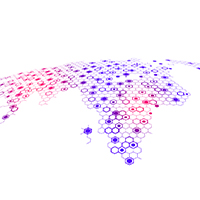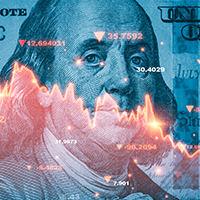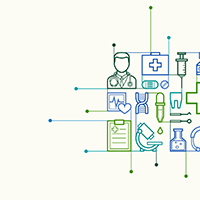How Trump's pharma tariffs will hurt industry and patients alike
Even before they've been formally announced, President Trump's 25% pharma import tariffs are succeeding in their goal of bringing more manufacturing to the United States. But that success will come at the cost of higher prices and possible shortages.
President Donald Trump's second term threw the world at large an unprecedented economic curveball when the controversial Republican began announcing large, indiscriminate tariffs against American allies and enemies alike.
What began on 1st February with tariffs on Canada, Mexico, and China escalated to a universal 10% tariff on imported goods from nearly every country in the world, with tariffs up to 50% on certain nations; on 2nd April, Trump's so-called "Liberation Day".
The 2nd April tariffs came with some apparently good news for the pharma industry, however, in that pharmaceuticals and semiconductors would be exempt from the tariffs. But it quickly became clear that this was only a reprieve, as the administration plans to impose even higher industry-specific tariffs on pharma – as high as 25% – in the name of encouraging more domestic manufacturing of pharmaceuticals.
Like so many of the Trump Administration's actions, it's a state of affairs that could hardly have been imagined a year ago, not the least because a 1994 World Trade Organization agreement, to which the United States was a signatory, exempts most pharmaceuticals from tariffs and duties in the name of global medicine access.
But international agreements are notoriously difficult to enforce, and pharma companies and patient advocates who were relying on that agreement to protect them are now gearing up for seemingly inevitable tariffs, which are likely to affect drug prices and pharma profits both in the US and elsewhere.
The realities of onshoring pharma production
The Trump Administration has made it clear why they're targeting pharma with tariffs: to bring more manufacturing to the United States, both for economic reasons and for reasons of national security.

"We cannot be relying on China for fundamental things that we need," US Commerce Secretary Howard Lutnick told ABC News. "Our medicines and our semiconductors need to be built in America."
A number of pharma companies, including Eli Lilly, Novartis, Roche, and Johnson & Johnson, have already announced major investments in US manufacturing either to get ahead of the tariffs or curry favour with the administration.
But, as a matter of policy, there are a number of problems with using tariffs as a lever to encourage domestic manufacturing. Stephen Farrelly, global lead of healthcare and pharma at ING research, spoke with Deep Dive about the impact of the tariffs.
"These are complex supply chains. They require skilled staff. They take time to build," he explained. "It is simply inconceivable that the pharmaceutical supply chain can be swiftly repositioned to the United States, even if all of those appropriate employees were there, even if all of the resources needed to effectively run the operation existed, even if the FDA approvals were already in place. This is a multi-year event that is impossible to realise within the scope of this current presidential term. These are medium to long-term shifts in the supply chain. In the short term, they're inflationary events."

Lobbying group PhRMA agrees, estimating that a new pharma plant can take five to 10 years to get operational at the cost of billions of dollars.
And even if pharma companies could magically move their manufacturing to the United States, there's still another problem: companies build their factories outside the US for a reason. Due to a range of factors from labour costs to economies of scale, it's simply more expensive to manufacture in the United States – which means drug prices would go up, not down.
Pharma companies are advocating for a phased rollout of any tariffs on a timescale that would enable them to actually meet the administration's goals.
They're also leveraging the moment to put pressure on the EU to create more favourable conditions. Earlier this month, the European Federation of Pharmaceutical Industries and Associations (EFPIA) warned European Commission President Ursula von der Leyen of an investment exodus to the US unless the EU institutes "rapid, radical policy change".
"The US now leads Europe on every investor metric from availability of capital, intellectual property, speed of approval to rewards for innovation," EFPIA said in a statement. "In addition to the uncertainty created by the threat of tariffs, there is little incentive to invest in the EU and significant drivers to relocate to the US."
Unique challenges for generics manufacturers
If the threat of tariffs appears to be working as intended on several large, branded pharma companies, the situation with generics is more complicated.
"Ninety percent of medications or prescriptions that are filled here in the US are generics," Merith Basey, executive director of Patients for Affordable Drugs Now, told Deep Dive. "Generics are the ones, obviously, that we're most concerned about, given that they operate on limited margins and these increases could substantially increase the cost for patients."

The economics of generics are very different from those of branded pharmaceuticals – because there is little to compete on other than price, margins are small, and companies depend on the economies of scale granted by high-population areas like India and China.
"For generics, especially for the lower-value generics that are produced in bulk, the economies of scale in India and China are so significant that even with tariffs, I don't see them coming back anytime soon," ING's Sector Economist for TMT & Healthcare Diederik Stadig told Deep Dive. "I don't think that the tariffs for generic pharmaceuticals will result in a big increase in [domestic] generic manufacturing capacity."
As the BBC reports, nearly half of all generic medicines in the US come from India, and Indian generics saved the United States $169 billion in healthcare costs in a single year.
If tariffs force generics manufacturers out of business, or make it unprofitable to do business with the US, the result could be not only higher prices but shortages, as there simply isn't an alternative source for some generics and raw materials.

"We already have seen a shortage for some important drugs since COVID in particular, for things like cancer drugs and antibiotics," Basey said. "I think the supply chain issues could also increase the probability of shortages, which is not what anyone wants or needs because we really do rely on that global supply chain to make these products."
While the tariffs and counter-tariffs on China have reached full-blown trade war status, there's reason to believe India could negotiate its way out of this. While the Trump administration flatly denies the tariffs are a negotiating tactic, history tells us otherwise: Trump has already used tariffs on Canada and Mexico precisely that way.
"If you take an economy like India, which also has a significant consumer electronics industry, we can imagine a dynamic whereby they do a deal on consumer electronics which protects the pharma supply chain because it ultimately it would be more damaging for the administration to raise the cost of pharmaceuticals in the US than it would the price of consumer electronics," Farrelly offered as an example.
Reconciling Trump's EO and tariff plans
Among analysts and academics, there's a broad consensus that tariffs will result in higher drug prices for patients – something that's hard to reconcile with the Executive Order that dropped on 15th April, even as the pharma industry waited for the other tariff shoe to drop.
"The bottom line is these tariffs are going to increase the price of already expensive medications in general for patients because, ultimately, it will be them who end up paying the bill," Basey said. "Regardless of the broader intent of the tariffs against pharma."
The Budget Lab at Yale, a nonpartisan policy research centre, estimates that a 25% pharmaceutical tariff would raise drug prices by 15% on average – around $600 per year per household.
The executive order in question, "Lowering Drug Prices by Once Again Putting Americans First", seeks to attack drug prices on a number of fronts, but some of them – such as Section 10, "Increasing Prescription Drug Importation to Lower Prices", seem to be directly in conflict with a broad tariff on pharmaceutical imports.
Farrelly and Stadig told Deep Dive in an email that accomplishing the goals of the executive order while implementing pharma tariffs would be a delicate balancing act to say the least.

"We continue to envisage tariffs on offshore pharma production as an inflationary event to the US system; however, at the same time, the latest order seeks to expand importation opportunities for generic drugs while increasing generic competition through deregulation," they said in an email. "The details of the proposed tariffs will be important in striking this balance, as will the potential reconsideration of the role of PBMs in the delivery chain. If an implemented tariff is a blanket tariff, margins in the middle of the pharma value chain would have to be squeezed very significantly as a result of this executive order and would have to make up for the price increase of generics. Otherwise, we do not see how prices could go down."
If the administration can't thread that needle, they'll have to deal with constituents who voted for President Trump, in part because he promised to lower drug prices.
"The administration has been running on a platform to lower costs in general," Basey said. "So, our understanding is, of course, that patients, and certainly those in our community who might have voted for the President, are keen to see those campaign promises realised."
About the author
Jonah Comstock is a veteran health tech and digital health reporter. In addition to covering the industry for nearly a decade through articles and podcasts, he is also an oft-seen face at digital health events and on digital health Twitter.
Supercharge your pharma insights: Sign up to pharmaphorum's newsletter for daily updates, weekly roundups, and in-depth analysis across all industry sectors.
Want to go deeper?
Continue your journey with these related reads from across pharmaphorum
Click on either of the images below for more articles from this edition of Deep Dive: Market Access and Commercialisation 2025












